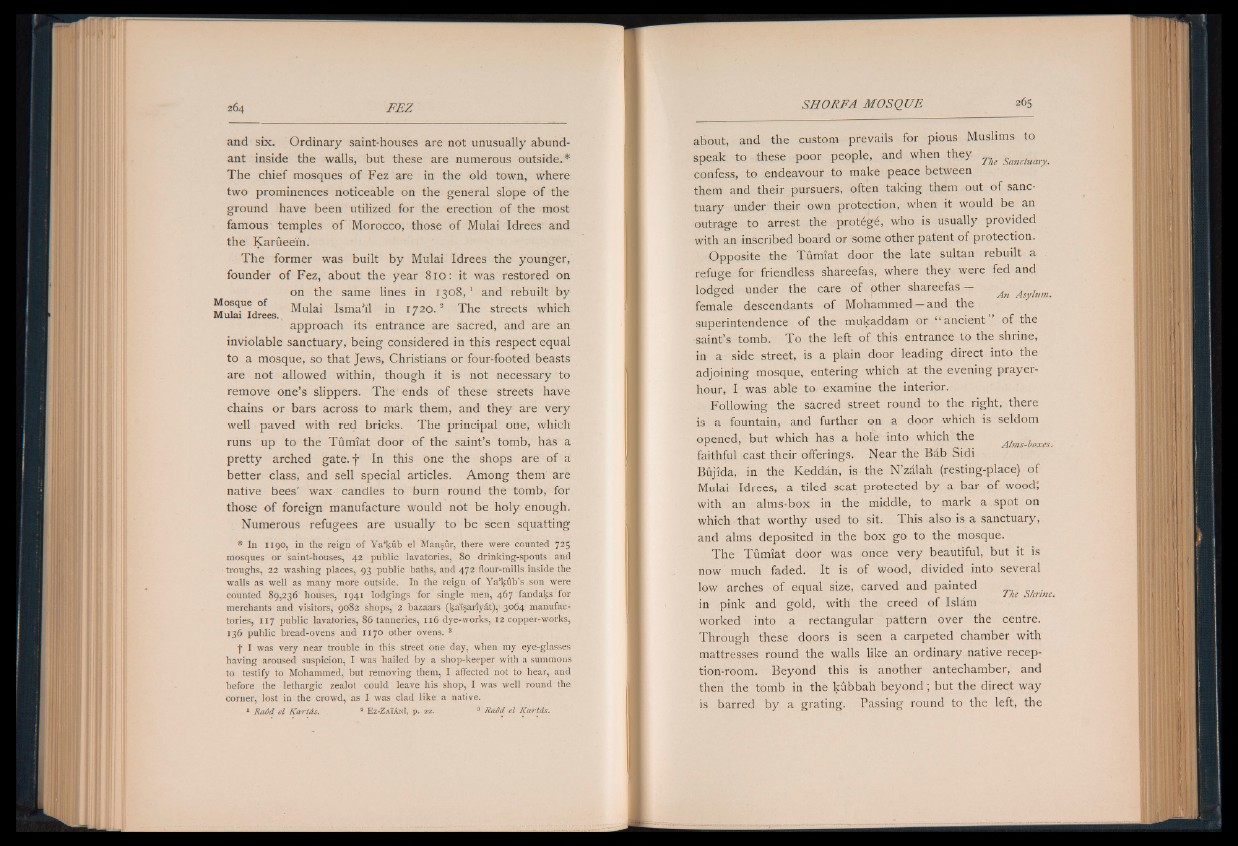
and six. Ordinary saint-houses are not unusually abundant
inside the walls, but these are numerous outside.*
The chief mosques of Fez are in the old town, where
two prominences noticeable on the general slope of the
ground have been utilized for the erection of the most
famous temples of Morocco, those of Mulai Idrees and
the Karueei'n.
The former was built by Mulai Idrees the younger,
founder of Fez, about the year 810: it was restored on
on the same lines in 1308,1 and rebuilt by
M u l a ^ ld r e e s Mulai Isma1]! in 1720.2 The streets which
approach its entrance are sacred, and are an
inviolable sanctuary, being considered in this respect equal
to a mosque, so that Jews, Christians or four-footed beasts
are not allowed within, though it is not necessary to
remove one’s slippers. The ends of these streets have
chains or bars across to mark them, and they are very
well paved with red bricks. The principal one, which
runs up to the Tumiat door of the saint’s tomb, has a
pretty arched gate, f In this one the shops are of a
better class, and sell special articles. Among them are
native bees’ wax candles to burn round the tomb, for
those o f foreign manufacture would not be holy enough.
Numerous refugees are usually to be seen squatting
* In 1190, in the reign of Ya’kub el Mansur, there were counted 725
mosques or saint-houses, 42 public lavatories, 80 drinking-spoiits and
troughs, 22 washing places, 93 public baths, and 472 flour-mills inside the
walls as well as many more outside. In the reign of Ya’qub’s .son were
counted 89,236 houses, 1941 lodgings for single men, 467 fandaks for
merchants and visitors, 9082 shops, 2 bazaars (kai'sariydt),' 3064 manufactories,
117 public lavatories, 86 tanneries, 116 dye-works, 12 copper-works,
136 public bread-ovens and 1170 other ovens. 3
t I was very near trouble in this street one day, when my eye-glasses
having aroused suspicion, I was hailed by a shop-keeper with a summons
to testify to Mohammed, but removing them, I affected not to hear, and
before the lethargic zealot could leave his shop, I was well round the
corner, lost in the crowd, as I was clad like a native.
1 Raod e l K a rtd s. . 2 E z - Z a ia n i , p . 22. 3 Raod e l K a rla s.
about, and the custom prevails for pious Muslims to
speak to these poor people, and when they ^ Sanciuary.
confess, to endeavour to make peace between
them and their pursuers, often taking them out of sanctuary
under their own protection, when it would be an
outrage to arrest the protégé, who is usually provided
with an inscribed board or some other patent of protection.
Opposite the Tûmîat door the late sultan rebuilt a
refuge for friendless shareefas, where they were fed and
lodged under the care of other shareefas - rggjf o
female descendants of Mohammed —and the
superintendence of the mukaddam or “ ancient of the
saint’s tomb. To the left of this entrance to the shrine,
in a side street, is a plain door leading direct into the
adjoining mosque, entering which at the evening prayer-
hour, I was able to examine the interior.
Following the sacred street round to the right, there
is a fountain, and further on a door which is seldom
opened, but which has a hole into which the ■,
faithful cast their offerings. Near the Bab Sidi
Bûjîda, in the Keddân, is the N’zâlah (resting-place) of
Mulai Idrees, a tiled seat protected by a bar of wood;
with an alms-box in the middle, to mark a spot on
which that worthy used to sit. This also is a sanctuary,
and alms deposited in the box go to the mosque.
The Tûmîat door was once very beautiful, but it is
now much faded. It is of wood, divided into several
low arches of equal size, carved A and paint/e d I he S/m■n.e*
in pink and gold, with the creed of Islam
worked into a rectangular pattern over the centre.
Through these doors is seen a carpeted chamber with
mattresses round the walls like an ordinary native reception
room. Beyond this is another antechamber, and
then the tomb in the kûbbah beyond ; but the direct way
is barred by a grating. Passing round to the left, the